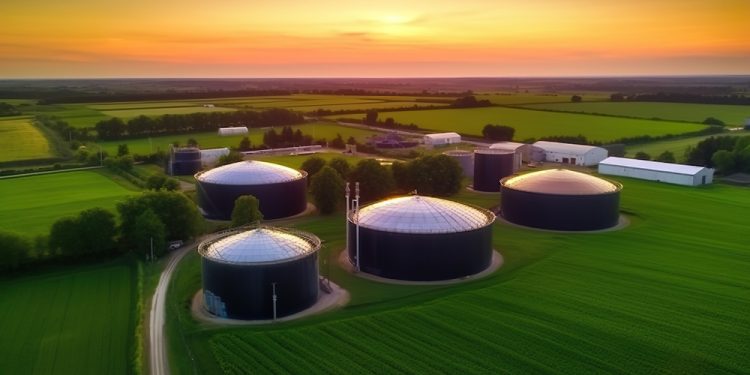Renewable Natural Gas (RNG), also known as biomethane, is a vital element of the low-carbon energy landscape. Derived from organic waste sources, RNG offers the environmental benefits of renewables combined with the practical compatibility of traditional natural gas. This primer examines the fundamentals of RNG: what it is, how it is produced, and why it matters.
What Is Renewable Natural Gas (RNG)?
RNG is a pipeline-quality gas that is chemically nearly identical to fossil natural gas. The primary difference lies in its origin; RNG is produced from the decomposition of organic waste, making it a renewable and lower-carbon alternative.
Common feedstocks include:
- Landfill gas
- Livestock manure
- Municipal wastewater sludge
- Food waste
- Agricultural residues
Since RNG comes from biological sources of methane, using it can help reduce greenhouse gas emissions, particularly methane, that would otherwise be released into the atmosphere from decaying organic matter.
The RNG Production Process
Producing RNG involves several key steps:
1. Feedstock Collection
Organic waste is collected from sources such as landfills, farms, food processing plants, and wastewater treatment facilities. The type and quality of the feedstock influence the efficiency and output of the process of biogas generation.
The collected organic material undergoes breakdown through anaerobic digestion (AD) or thermal gasification.
- Anaerobic digestion involves microorganisms that break down organic matter without oxygen, generating biogas, which is a mixture of methane (CH₄) and carbon dioxide (CO₂).
- Gasification is a thermochemical process that converts biomass into syngas, which can subsequently be processed into methane.
2. Biogas Upgrading
Raw biogas typically contains 50–60% methane and 40–50% carbon dioxide, along with impurities such as hydrogen sulfide and siloxanes. It must be purified and upgraded to achieve a methane content exceeding 90% in order to meet pipeline standards.
This is achieved through:
- Membrane separation
- Pressure swing adsorption
- Water or chemical scrubbing
3. Injection and Distribution
Once upgraded, RNG can be injected into existing natural gas pipelines, used as vehicle fuel (either compressed or liquefied), or supplied directly to industrial and residential users.
RNG vs Fossil Natural Gas
| Aspect | RNG | Fossil Natural Gas |
| Source | Organic waste | Underground fossil reserves |
| Carbon Footprint | Low or negative | High |
| Infrastructure | Fully compatible | Fully compatible |
| Supply Potential | Limited but growing | Abundant but finite |
| Sustainability | Renewable | Non-renewable |
Environmental and Economic Benefits of RNG
1. Methane Emissions Reduction
RNG captures methane that would otherwise be released from landfills, manure lagoons, or decaying waste, converting a potent greenhouse gas into usable energy.
2. Waste Management
RNG systems offer a sustainable method for managing agricultural and food waste, contributing to the reduction of landfill use and contamination.
3. Energy Security
Decentralized and local RNG production can reduce reliance on imported fossil fuels and enhance resilience.
4. Job Creation
The development, operation, and maintenance of RNG plants generate jobs in engineering, construction, and agriculture.
Common Renewable Natural Gas Applications in Transportation, Power, and Industry
1. Transportation Fuel for Fleets and Heavy-Duty Vehicles
Renewable Natural Gas is increasingly used as a low-carbon alternative to diesel and gasoline in the transportation sector. When upgraded to pipeline quality, RNG can be compressed (CNG) or liquefied (LNG) for use in trucks, buses, refuse haulers, and delivery fleets. Many transit authorities and commercial logistics companies are transitioning to RNG to meet emissions reduction goals while utilizing existing natural gas engines. RNG offers lifecycle greenhouse gas reductions of up to 90% compared to diesel, making it an ideal fuel for companies focused on sustainability.
2. Power Generation and Electricity Supply
RNG can be used to generate electricity through combustion in turbines, engines, or fuel cells. This is particularly beneficial for microgrids, combined heat and power (CHP) systems, or off-grid facilities that need a reliable and renewable energy source. Because RNG is dispatchable (unlike wind or solar), it can provide baseload or peaking power in distributed energy systems. This application supports grid reliability while contributing to greenhouse gas reduction goals.
3. Industrial Heat and Process Energy
Industries that require high-temperature heat—such as manufacturing, chemical processing, food and beverage production, and cement—can use RNG as a direct substitute for fossil natural gas. RNG enables these sectors to reduce their carbon footprint without the need to overhaul their existing gas-fired equipment or infrastructure. In some jurisdictions, using RNG can also help companies meet regulatory requirements or qualify for emissions credits.
4. Residential and Commercial Heating and Cooking
RNG can be injected into existing natural gas pipelines and used interchangeably with fossil gas in homes and commercial buildings. This includes applications like space heating, water heating, and cooking. Utilities can offer RNG as a “green gas” option to customers looking to lower their carbon footprint without changing appliances or behavior. Over time, wider RNG adoption in residential use could help decarbonize heating systems in colder climates where electrification is challenging.
Challenges Facing Renewable Natural Gas Development and Adoption
Despite its promise, RNG faces several barriers to widespread deployment:
- High Production Costs Compared to Fossil Gas: RNG remains more expensive to produce than conventional natural gas, largely due to the costs associated with feedstock handling, biogas upgrading, and compliance requirements.
- Feedstock Limitations, Particularly in Urban Areas: Access to consistent, high-quality organic waste can be limited – especially in densely populated areas where space, collection logistics, and competition for feedstock present obstacles.
- Regulatory Complexity in Interconnection and Permitting: RNG projects often face lengthy and complicated regulatory processes, including environmental permitting, pipeline interconnection approvals, and compliance with air and water quality standards.
- Scaling Issues Due to Limited Output: Current RNG production volumes are small relative to national natural gas demand. Significant infrastructure investment and policy support are needed to scale the industry and expand market access.
The Future of Renewable Natural Gas in the Clean Energy Transition
Renewable Natural Gas bridges the gap between sustainability and reliability. It offers a practical approach to decarbonizing gas infrastructure by utilizing existing systems, while also reducing emissions from agriculture, waste, and transportation. As technology advances and policy support grows, RNG is poised to become a cornerstone of the clean energy economy.
Partnering for Renewable Natural Gas Success: Legal Guidance for Developers and Energy Stakeholders
If your organization is exploring opportunities in RNG, whether in project development, financing, compliance, or long-term strategy, Avisen Legal’s energy law team is here to help. Contact us to discuss how we can support your goals with practical, business-focused legal guidance.






